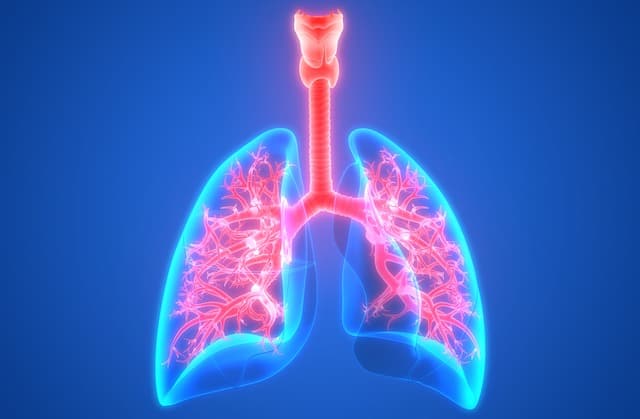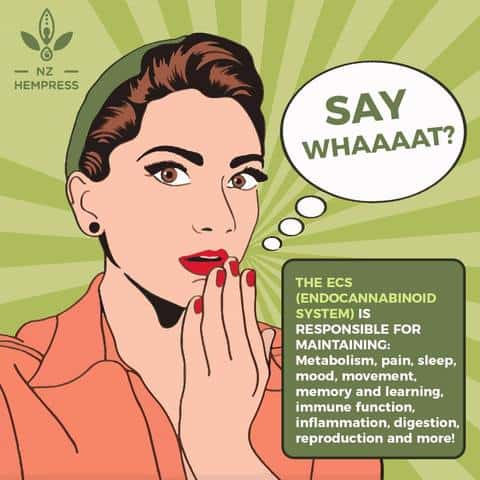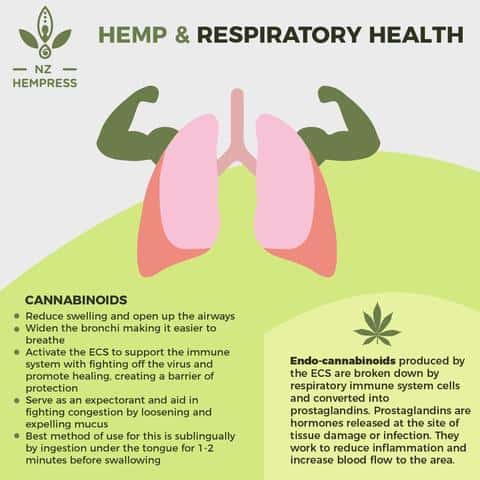
Always excited to share these with you!
This NZ Hempress blog post covers the benefits of hemp seed extract for COPD and other respiratory diseases and conditions because there is sufficient evidence on how cannabinoids work both directly in the body and through the endocannabinoid system to bring relief to those suffering from such ailments.
Before we get into hemp seed extract for COPD and other lung and wider related issues, we’ll cover the respiratory system health, the stats in New Zealand and the resulting conditions symptomatology.
Hemp Seed Extract & Respiratory Diseases
The respiratory system is comprised of the nose, mouth, larynx, pharynx, trachea, bronchi and bronchioles, lungs, and respiratory muscles.
The most common respiratory diseases in New Zealand include asthma, chronic obstructive pulmonary disease (COPD), lung cancer, obstructive sleep apnoea, bronchiectasis, childhood bronchiolitis and childhood pneumonia.
Other common respiratory diseases include Tuberculosis, Emphysema, Pneumonia, Cystic Fibrosis, Cancer, Common Colds, Acute Respiratory Distress Syndrome, Asthma and a few infections like pharyngitis, tonsillitis, sinusitis, otitis media and laryngitis.
In New Zealand, frighteningly, respiratory diseases are the third most common cause of death and cost kiwi’s more than $5.5 billion every year (that’s a lot of taxpayer money).
Unfortunately 1 in 6 Kiwis live with some form of respiratory condition, and the rates are rising while 1 in 8 hospital stays are respiratory disease related.
People living in deprived poorer households are admitted to hospital three times more often than those living in wealthier areas. In New Zealand, across all age groups, hospitalisation occurs more in Pacific peoples (2.6 times higher) and Maori (2.1 times higher) than for other ethnic groups (Telfar Barnard et al., 2015).
Respiratory Disease Causes

To make matters more complicated, the soil in which our produce is grown is also deficient in selenium. Deficiency in selenium during gestation, breastfeeding and early years is linked to the onset of asthma and other respiratory conditions. To provide a clearer picture, in New Zealand 1 in 7 children have asthma, which is double the rates compared to 1 in 11 in the USA.
https://www.cdc.gov/nchs/fastats/asthma.htm
Farmers regularly supplement livestock troughs with liquid selenium, so why aren’t we consuming brazil nuts, which are high in selenium (roughly one per day) or supplementing with selenium, too?
One study from 2016 published in the Journal of Thoracic Disease found there was a significant correlation between low selenium levels and the onset and exacerbation of respiratory disease.
https://www.ncbi.nlm.nih.gov/pmc/articles/PMC4999709/
Common symptoms of respiratory diseases include:
Continuous cough (may also be accompanied by mucus)
Breathing issues like wheezing or shortness of breath
Tightness or uneasiness in the chest area
Throat ache due to soreness and inflammation, may cause change in voice
Swelling in toes and fingers due to improper breathing
Blood with a cough
With symptoms ranging from more mild to severe, it’s important to get and keep them under control as much as possible. Breathing is so integral to our health, being that we take our first breath when we’re born, and our last when we pass, it’s so vital that we manage our respiratory health in the fullest, most proactive way possible.
Common causes of respiratory diseases include:
Inappropriate development of the lungs in gestation or childhood
Low immune functioning
Excessive exposure to smoke and other toxic materials
Adverse climatic conditions and intolerable air pollution
Presence of fungal, viral and bacterial infections
With the rates of respiratory diseases and conditions being so high in New Zealand, we need to be aware of what we can do to improve not only our current health climate, but also the respiratory health of future generations, our kids.
In one study from 2015, researchers found diets high in fruits and vegetables were associated with benefits in respiratory diseases. This included a Mediterranean style diet, rich in fruits and vegetables, with some fish that included omega-3’s such as Salmon, Tuna and Mackerel.
https://www.ncbi.nlm.nih.gov/pmc/articles/PMC4377870/
They also found the more people consumed fast food and followed western dietary patterns like the standard american diet (SAD), the higher the risk of developing respiratory diseases such as COPD and asthma.
Researchers also noted that there is evidence for vitamin D in assisting with lung development and immune function (by sunlight or supplementation).
They also noted overconsumption of calories (food) called ‘overnutrition’ causes detrimental effects to respiratory health.
Finally, there are advanced forms of supplementation such as with Vitamin A, that appear to be of assistance in helping with COPD development and preventing similar conditions from worsening.
https://www.ncbi.nlm.nih.gov/pmc/articles/PMC6164133/
Hemp Seed Extract activates the ECS

Cannabinoid receptors are found in the lungs in structural and immune cells. Endocannabinoids produced by the endocannabinoid system (ECS) are broken down by the respiratory immune system cells and converted into prostaglandins.
Prostaglandins are hormones released at the site of tissue damage or infection. They work to reduce inflammation and increase blood flow to the area. The hormones are also able to create blood clots in the areas of injury to prevent blood loss.
The endocannabinoid system is an advanced system of physiology inside your body thats sole purpose is to bring balance and order to every other system of the body. That’s a big job, so we best hope the ECS is alive and active, right?
Trouble is, when the ECS becomes overwhelmed it can become inactive through an insufficient supply of cannabinoids. The ECS makes its own cannabinoids, but when overstressed, it relies on a top up of cannabinoids from our diets. When we don’t supplement with cannabinoids or get them from the foods we eat, this healing system of the body cannot do its job.
In 1930, many western countries around the world banned the once-profitable and highly useful (along with non-psychoactive cousin of marijuana), the hemp plant, from being grown by farmers.
This resulted in cannabinoids eventually drying up from our food supply, where it was once abundant (through pollination). Hemp seed extract or simply cannabinoids showing up in our fruits and vegetables used to assist our ECS is remaining active and healthy.
To give you a clearer picture, the ECS is so integral to the healthy functioning of our physiology, that it has been seen to begin forming at 8-weeks gestation in the womb and natural cannabinoids produced by the mother are present in breastmilk.
The exciting news is that hemp is back, along with cannabinoids, but nothing like it once was (we’re working on that). Hemp contains a well documented 120+ cannabinoids with scientists discovering more cannabinoids every week.
Next we’ll discuss how hemp seed extract combined with cannabinoids in a full spectrum product can assist with COPD and other respiratory diseases. You can view further scientific research from peer reviewed medical journals in the footnotes of this article.
Hemp Oil Benefits for Inflammation

Conditions involving inflammation in the respiratory system, such as asthma, are common. In the case of the respiratory system, inflammation is not only uncomfortable but can impair the individual’s capability to breath normally.
Cannabidiol (CBD) will provide the needed chemical compounds to reduce swelling and open up the airways. CBD is considered to be a bronchodilator, which causes widening of the bronchi and makes it easier for the user to breathe.
https://cannador.com/articles/single/medical-benefits-of-alpha-pinene
Bronchiolitis and bronchitis are viral infections of the lungs and are contagious. Cannabinoids such as CBD can support the immune system with fighting off the virus, promoting healing, and creating a barrier of protection. This is what makes a quality hemp seed extract so important.
Infections affecting the nose, mouth, and throat are also treatable with the utilization of CBD. CBD serves as an expectorant and aids in fighting congestion by loosening and expelling the mucus.
How to use Hemp Seed Extract
There is a split opinion on vaping and inhaling hemp products for those with respiratory health issues like lung disease or COPD. Some state that these methods can increase risks of respiratory problems in the user and should be avoided, others say the data is inconclusive and these are viable options.
Ingesting a hemp product is a way to avoid the debate or concerns. Tinctures are available to be used sublingually. This involves holding the tincture under the tongue for one to two minutes and swallowing. Capsules are a good option for those who don’t particularly care for the taste of tinctures.
We hope this article has provided you with sufficient information and studies relating to how a hemp seed extract can assist with respiratory diseases and conditions such as COPD and asthma and how you can use cannabinoids to activate the endocannabinoid system to bring more relief to inflammation of the lungs and other systems of the body.
If you found this post insightful, consider sharing it with a friend.
Prior to making changes to your lifestyle or treatment plan, always consult your Doctor.
https://copdnewstoday.com/2016/12/08/inmed-announces-progress-copd-treatment-using-cannabinoids/


About The Author: Callumfatweb
More posts by Callumfatweb